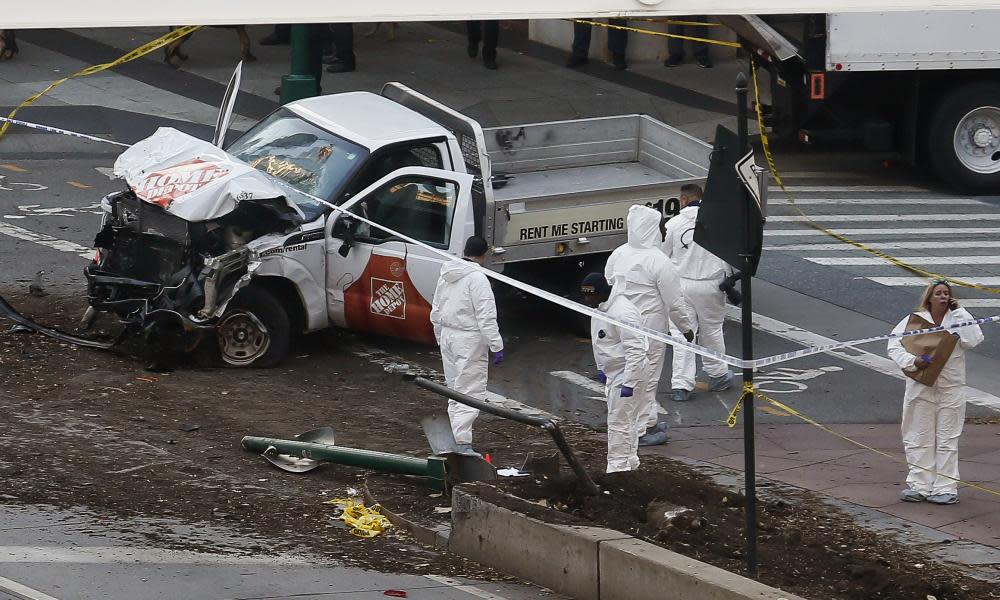Manhattan attacker used a truck – urban terrorist's weapon of choice

The attacker who turned a Home Depot truck into a deadly weapon in New York City on Tuesday used a method that has become familiar in terror attacks across the world.
At least eight people are dead after a man drove 20 blocks beside the Hudson River in Lower Manhattan on Tuesday afternoon, using a truck to plough into people on a pedestrian and bicycle path. Pictures of the mangled truck taken after it eventually ploughed into a school bus, only a few blocks from the site of the One World Trade Center building at 9/11 “ground zero”, indicate that it was a rental vehicle.
It has become an increasingly familiar sight in the wake of terror attacks and follows a disturbing trend of terrorists who need only a driver’s licence to arm themselves with a deadly weapon.
The vehicles used in recent high-profile terror attacks are similar in that none of them have been owned by the attackers.
Khalid Masood, a British citizen, rented the 4x4 he used to mow down pedestrians on London’s Westminster Bridge in March, killing four people, then fatally stabbed a policeman before being shot dead by police.
Then in June three terrorists killed eight people after driving a van into pedestrians on London Bridge before attacking nearby revellers. It later emerged the group had initially tried to hire a 7.5-tonne truck but were unsuccessful.
The most devastating such attacks happened in July last year when Mohamed Lahouaiej-Bouhlel used a hired 19-tonne cargo truck to kill 86 people in Nice on Bastille Day. Then in December a truck was deliberately driven into a crowded Christmas market in Berlin, killing 12. On that occasion Anis Amri hijacked a lorry before driving it into the crowd.
In April this year a 39-year-old man from Uzbekistan hijacked a beer delivery truck and drove it into crowds on Stockholm’s largest shopping street, killing four people.
Sayfullo Saipov, the suspect believed to have carried out Tuesday’s attack in New York, is a Uzbekistan national who had been living in the US since 2010.
In August this year far-right supporter James Fields drover a car into a crowd in Charlottesville, Virginia, killing one person and injuring 19. The same month, Younes Abouyaaqoub drove a van into the crowded Las Ramblas mall in Barcelona, killing at least 13 and injuring more than 130. Another suspect, Moussa Oukabir, is thought to have rented the van. Oukabir, a teenager, was suspected of using his brother’s documents to hire the vehicle that ploughed through pedestrians in the tourist hotspot.
The attacks underline the enormous challenges facing security agencies tasked with stopping these low-tech terrorists.
While governments have responded to the increased frequency of vehicle attacks with a focus on passive security measures like bollards in public spaces, the ease of access to cars and trucks for would-be terrorists means they are now actively promoted among terror groups.
Rumiyah, the online propaganda magazine published by the terror group ISIS, has encouraged supporters to carry out attacks using vehicles because of the difficulty associated with preventing the attacks.
In an issue of the magazine published last year, it encouraged supporters to use a truck to “crush” victims, then use a “secondary weapon” to “finish his operation on foot”. It also told its supporters to leave a note declaring allegiance to ISIS.
23. The steps Rumiyah spells out include use a truck, crush ppl, then get out on foot & use a secondary weapon AND leave a note: pic.twitter.com/XHqpikThXK
— Rukmini Callimachi (@rcallimachi) November 1, 2017
In the UK, government, police and the vehicle rental industry are already discussing ways to tighten regulations around who can hire vehicles. While current checks are limited to identity, credit and insurance, there are discussions about whether customers could be cross-checked immediately by police against terrorist watch lists.

 Yahoo News
Yahoo News 
